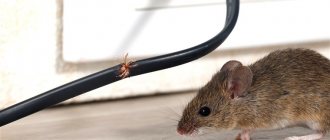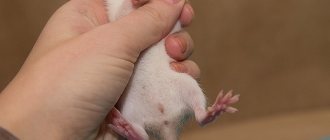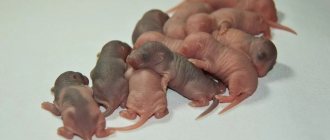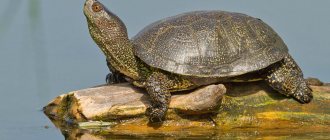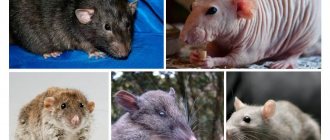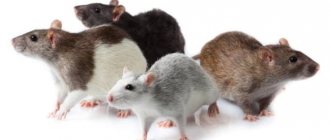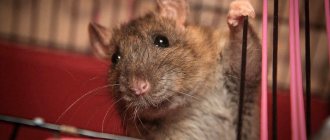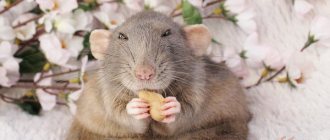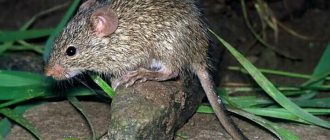Appearance
Mouse Rat
To the uninformed person, rats and mice appear almost identical due to their elongated body, gray fur and long tail. Both animals actually belong to the same mouse family. But they belong to different species, and differ in appearance in several ways:
- Body dimensions. Rats are much larger. Their body length (without tail) is on average 22-25 cm, although there are also individuals up to 30 cm long. Weight - 400-500 g. Mice are more compact - the distance from the tip of the nose to the tail is only 8-11 cm. And they weigh mice 50-80 g.
- Tail. Mouse tails are relatively short - their length is approximately 55-60% of the length of the body. Rats use their tail as a fifth limb, so they have it thicker and longer. Its length is comparable to the size of the animal's body.
- Head. The muzzle of rats is more elongated and pointed, with relatively small beady eyes and triangular or oval ears. Mice have a more rounded muzzle with larger eyes. Their ears are also much larger and have a rounded shape. Mice can easily wiggle their ears and turn their heads in all directions without using their entire body. Rats have immobile ears; to look to the side, they need to turn their body.
- Paws. Mice have more graceful paws with prehensile claws that help them easily climb vertical surfaces. The paws of rats are more powerful, and there are rough skin growths between the toes.
- Wool. If we talk about wild rats, their fur is quite hard to the touch and has a dirty gray color. The fur of mice is softer, shimmers pleasantly in the sun and has an interesting smoky gray hue. Decorative rats, unlike their wild relatives, also boast beautiful soft fur of a wide variety of colors.
Sometimes among pasyuks there are individuals of gigantic size. The body length of wild rats can reach 40-45 cm, and the weight is about 1 kilogram.
Duration and lifestyle
Mouse
Rats, like mice, are predominantly nocturnal. During the day they rest and gain strength, and after sunset they go hunting in search of food. Despite the fact that both species of rodents live in packs, mice hunt alone.
Rats, on the contrary, prefer to attack prey in large groups. Therefore, they can be dangerous even for animals that are much larger than themselves. Rats are also more aggressive - in a fight with an enemy, they go to the last, fighting for life and death.
The lifespan of mice is slightly shorter than that of rats. On average, mice live 1-1.5 years. However, at home they can live up to 2.5 years. The lifespan of a rat is somewhat longer - 2.5-3 years. Although this indicator can vary greatly depending on the type of rat. For example, albinos rarely live longer than one and a half years.
Home for rodents
The habitats of these two representatives of the animal world are very diverse. Rats are not at all afraid of very hot climates or severe frosts. The homeland of these animals is Eastern China. Thanks to the development of shipping, they settled throughout the planet. These animals are very active at night, but if necessary, they explore new spaces during the day. Most often they live in burrows, which are very similar to labyrinths. There they make their nest, where they hatch and feed their offspring. All holes are made in such a way that they lead to the very center of this nest, which they carefully line with grass, wool and dry leaves. These dwellings are available for winter and summer.
Mice also live in burrows. Throughout the year they replenish their reserves for the winter. These animals are very shy and most often they are nocturnal. Their burrow is also a kind of labyrinth where a whole family lives, but one animal can also live. Despite their small size, in case of danger they will be able to boldly and bravely defend their shelter.
The teeth of these rodents are also different. Rats have only two types: 12 molars, 3 on different sides of the jaw, and 4 incisors.
The molars are very wide and flat, they are located far away in order to grind food well by chewing it. And their incisors grow throughout their lives; they use them to chew through very hard objects. Their teeth are yellow in color and have strong enamel. They have a very interesting feature - they can be moved apart when chewing food.
What do different types of rats look like?
These rodents avoid water whenever possible. But pasyuks are good swimmers and can stay in the water for up to several hours; sometimes, to get food, they dive deep, hunting for various mollusks and even frogs, and are not afraid to be under water for a long time.
Character and behavior
Little Rat
Mice and rats, especially decorative ones, are peaceful animals that are not prone to unreasonable aggression. The only exception is that during sexual activity and during hunting, rats can be very militant.
When it comes to relationships with people, mice are more timid. Seeing a person or hearing his approaching steps, the mouse will immediately hide so as not to become noticed.
Rats are calmer and more sociable. They are much easier to tame. In addition, decorative rats interact well with other pets. The main thing is to carefully monitor the interaction of pets in order to come to the rodent’s aid if a large animal (cat or dog) suddenly awakens its hunting instinct.
Intelligence
Little Rat
It has now been proven that the cognitive abilities of rats are much higher than those of mice. They adapt faster to changing environmental conditions, are more careful, and are able to independently regulate the size of the flock. For example, if the demographic situation declines, rats begin to actively reproduce. Mice do not have such abilities.
Scientists have found that the intelligence of rats is comparable to that of a cat or dog. Ornamental rodents can even be trained by performing simple commands and tricks. A domestic rat is able to respond to its name and use the litter tray to go to the toilet.
For a long time, it was believed that among all mammals, only humans were given the ability to smile. However, it has recently been discovered that rats also have a sense of humor. And if you wish, sometimes you can notice a slight smile on their sly little face.
Rats are also more social. They are able to take care of their relatives - they lick each other, feed weakened and sick individuals, and warn of approaching danger. Often rats even sleep together, in groups, pressed tightly against each other.
Nutrition
Baby rat
Both types of rodents are omnivores; if necessary, they will find food in any conditions. However, their food preferences are still different. Rats are true predators; their diet necessarily includes animal protein. Therefore, owners of decorative rodents must include the following products in their daily menu:
- lean meat - chicken breasts, rabbit, turkey, lean beef;
- boiled fish;
- seafood - shrimp, crabs, squid;
- fermented milk products - crumbly cottage cheese, yogurt without dyes, curdled milk, Varenets;
- dried mealworm and insects.
Mice are also not averse to eating protein food, but they tolerate its absence much more calmly. The basis of the diet of tiny animals is cereals (wheat, rye, oats, rice, millet), as well as seeds of various plants. They can attack insects and are also not averse to eating their larvae. In conditions of food shortage, they can even feed on leather items, soap, and paraffin.
If we talk about the drinking regime, then in rats it is more plentiful. For normal functioning of a sexually mature individual, 30-35 ml of liquid is required. It is enough for a mouse to drink 10 times less water - about 3 ml.
Natural enemies
In nature, babies have many enemies, so they are at the middle level of the natural food chain. Among the enemies of small rodents, predatory animals and birds stand out.
Fact! The main hunter of the little mouse is the owl.
Also, snakes, forest cats, foxes and weasels are not averse to eating small rodents. The behavior of a baby mouse at the time of an attempted attack by a predator is not courageous. The mouse becomes timid and freezes in place, and then rushes as fast as it can.
The difference between a mouse and a rat
Baby rat
Baby rats and mice are born very tiny, completely naked and blind. Therefore, it is simply impossible to distinguish them at first glance. However, for experienced zoologists, the differences between newborn mice and rat pups are obvious:
- mice have a round body shape, while the body of baby rats is oblong;
- the little mice are distinguished by a slightly flattened muzzle, while the little rats' faces are stretched forward;
- mouse ears have an almost round shape and are quite large compared to the size of the head; the ears of baby rats are smaller and slightly pointed or blunt at the tips;
- rat pups have a more developed tail - it is quite thick and long, while mouse tails are short and graceful, and also more mobile;
- during sleep, baby rats prefer to roll over on their backs and spread their paws in different directions, while mice sleep in a ball, like kittens;
- Mouse paws lack the characteristic webbing between the toes of rats.
If you look at the litter as a whole, you can determine whether it belongs to one or another species by the number of babies. Mice give birth to fewer babies - 5-10. In rats, the offspring are more numerous - each pregnancy ends with the birth of 12-15 rat pups. Sometimes the number of rat droppings reaches 22-24 pups.
As they get older, the differences become more obvious. Mice open their eyes earlier - after about 5 days, and are completely covered with hair after 10 days. In rat pups, these physiological processes take approximately 2 times longer. But at two weeks of age, the baby rat’s body parameters are comparable to the size of an adult mouse.
How to determine the type of spoiled food
You can also distinguish a mouse from a rat by the type of spoiled food.
If there are rodents in the house, you can determine their species according to the following behavioral characteristics:
- Cereals. When eating cereals, rats consume the grains without leaving any traces behind. Mice leave behind husks and spoiled grains.
- Small representatives of the family prefer to eat in only one place, while large ones cause serious damage to the household and food supplies, choosing new food sources each time.
If rodents have settled in the house, it is important to be able to determine their species, since control methods differ. To exterminate mice, you need to choose a trap or insecticides; to remove large rodents, you need to call professional exterminators, since these animals are extremely careful, cunning, and smart.
What are the similarities between a mouse and a rat?
Mice
Despite the large number of differences between rats and mice, these representatives of rodents have much in common. For example:
- lead a predominantly nocturnal lifestyle;
- similarity in appearance - achieved thanks to gray fur, large front incisors and a bare tail;
- both types of animals are inextricably linked with humans - wild rats look for food among household waste, and mice prefer to feast on farmland;
- have high vitality, are mobile, flexible - they constantly study the world around them and are always ready to frolic;
- live in numerous colonies, in which a clear hierarchy can be traced;
- cleanliness - rodents carefully wash themselves and lick each other’s fur; they also maintain cleanliness in their homes;
- both types of animals are easily tamed - currently breeders have created many decorative subspecies of mice and rats that are ideally adapted to life at home.
Separately, we can note the very high fertility of both rats and mice. Females of both rodent species are ready to mate within a few hours of giving birth. Therefore, if the reproduction process is not limited by artificial means, females will be constantly involved in bearing and feeding offspring.
It is very important for novice rodent breeders to know the parameters by which a rat and a mouse differ - the main differences and similarities will help determine the choice of a pet. And in the future, they will allow you to keep your pet in the most comfortable conditions.
Puberty
Mice reach maturity quite early. In females, the first estrus begins at the age of 30-35 days. The males' readiness to mate is indicated by the descent of the testes into the scrotum. This occurs around the 5th to 7th week of life.
Males can breed all year round. The ability to reproduce in males remains until old age, provided that they are kept in good conditions and receive adequate nutrition.
Despite such early puberty, it is not advisable for a female to give birth to cubs after her first heat. Her body continues to form and is not yet ready for reproduction. Complications may occur during pregnancy or childbirth. For this reason, rodentologists recommend waiting for at least 3 months with the first mating of a female.
